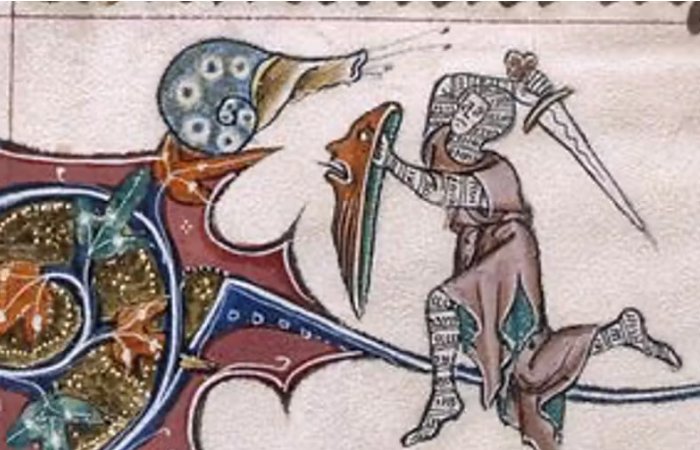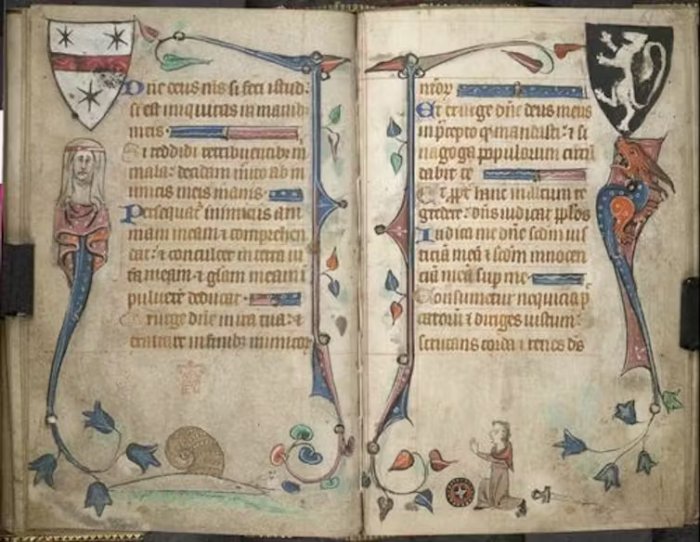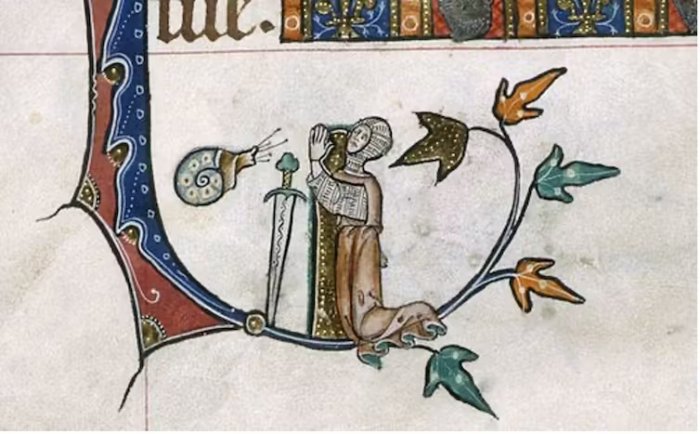Why Are Medieval Manuscripts Full Of Doodles Of Snail Fights?
AncientPages.com - The doodles found in the margins of very old manuscripts are often just as interesting as the content of the manuscripts themselves. One such example is the frequently recurring – and extremely odd – image of knights warring against snails.
From the late 13th century through to the 15th century, images of knights fighting snails pop up in all sorts of unlikely places within the medieval literary world. And they reveal fascinating insights into what medieval people thought about the world around them.
Battle in the margins from the Gorleston Psalter (1310-1324). British Library
Images of knights fighting snails first started to emerge in North French illuminated manuscripts (which are decorated with richly coloured illustrations) towards the end of the 13th century (around 1290). A few years on – although slightly less consistently – these same images started appearing in Flemish and English manuscripts.
Interestingly, in most cases these snail doodles appear to be unrelated to the adjoining illustrations of textual passages.
Often, the doodles depicted an armed knight confronting a snail whose horns were extended and pointing like arrows. In the manuscripts of the French folktale, Le Roman de Renart, the weapons that the knights were depicted with varied between sticks, maces, flails, axes, swords and even forks.
Snail assailants are almost always male knights. However, there is one known instance of a woman opposing a snail wielding a spear and shield.
As these snail combat doodles increased in popularity within manuscripts, they became an accepted element of medieval imagery. From here, they spread to other areas of medieval life.
Decorative panels carved around 1310 on the main entrance of Lyon Cathedral in France, for example, showcase a knight confronting a snail and another man threatening a dog-headed giant snail with an axe.
Despite travelling across the continent, the knights versus snails motif varied little from country to country, which suggests that it may have had a deeper meaning.
Medieval satire
Nobody knows exactly why battles between snails and knights were so popular throughout the middle ages. One theory is that these doodles added humour to texts which were otherwise quite dry and serious.
A reader could rest their eyes by taking a moment to laugh at the scene of snail combat before continuing with their reading.
Extreme jousting from Brunetto Latini’s Li Livres dou Tresor, (c. 1315-1325). Courtesy of the British Library
Many of the doodles show a knight dropping their sword or kneeling submissively before their diminutive shelled foe, which accentuates its satirical implications. There are also several representations of women pleading with knights not to attack the formidable beasts.
Other similarly lighthearted imagery includes a cat stalking a snail with the head of a mouse, as well as dogs, monkeys, dragons and even rabbits in fierce opposition with the molluscs.
The meaning of the snail motif
Snails were recognised in medieval times for their unusual strength, given that they were able to carry their home on their back. Confrontation with a snail, therefore, could represent a test of personal strength as well as mental fortitude.
Once a symbol of deceptive courage, the snail became a creature to be hunted down and destroyed in a display of strength and bravery.
A disarmed monk faces a snail opponent, from The Book of Hours (c. 1320-1330). Courtesy of the British Library
Like many other subjects popularised in marginal illuminations of the 1300s, the snail and knight duo gradually disappeared as time wore on. They experienced a brief revival, however, in medieval manuscripts towards the end of the 15th century.
The gastropod conqueror from the Gorleston Psalter, 1310-1324. Courtesy of the British Library
A knight versus snail fight from the Smithfield Decretals ( c.1300-1340). Courtesy of the British Library
And they haven’t completely disappeared from the common imagination. Today the pairing can still be enjoyed in the nursery rhyme, Four-and-Twenty Tailors Went To Kill a Snail:
Four-and-twenty tailors went to kill a snail,
The best man amongst them durst not touch her tail;
She put out her horns like a little Kyloe cow;
Run, tailors, run, or she’ll kill you all e’en now.
Written by Madeleine S. Killacky, PhD Candidate, Medieval Literature, Bangor University
Provided by The Conversation
This article is republished from The Conversation under a Creative Commons license. Read the original article.
More From Ancient Pages
-
 Roman Square Capitals: Prestigious Script That Delighted Human Eye With Its Elegance
Featured Stories | Sep 16, 2019
Roman Square Capitals: Prestigious Script That Delighted Human Eye With Its Elegance
Featured Stories | Sep 16, 2019 -
 Why Was Dorset Ancient Mega Henge Built In Such A Hurry?
Archaeology | Nov 5, 2020
Why Was Dorset Ancient Mega Henge Built In Such A Hurry?
Archaeology | Nov 5, 2020 -
 Aboriginal People Made Pottery And Navigated To Remote Islands Millennia Before Europeans Arrived
Featured Stories | Aug 19, 2024
Aboriginal People Made Pottery And Navigated To Remote Islands Millennia Before Europeans Arrived
Featured Stories | Aug 19, 2024 -
 Is Mysterious Pokaini Forest An Ancient Healing Center And Anomalous Zone?
Featured Stories | Aug 13, 2018
Is Mysterious Pokaini Forest An Ancient Healing Center And Anomalous Zone?
Featured Stories | Aug 13, 2018 -
 Keeladi, India: Ancient Residents Along Vaigai River Had Adopted Highly Progressive Technologies
Archaeology | Aug 28, 2020
Keeladi, India: Ancient Residents Along Vaigai River Had Adopted Highly Progressive Technologies
Archaeology | Aug 28, 2020 -
 Mystery Of Giant Ancient Statues And A Vanished Civilization With Unusual Physical Characteristics – Strange American Connection – Part 2
Civilizations | Aug 20, 2020
Mystery Of Giant Ancient Statues And A Vanished Civilization With Unusual Physical Characteristics – Strange American Connection – Part 2
Civilizations | Aug 20, 2020 -
 Underwater Drone Images Reveal Oldest Human-Made Structure In The Baltic Sea
Archaeology | Feb 13, 2024
Underwater Drone Images Reveal Oldest Human-Made Structure In The Baltic Sea
Archaeology | Feb 13, 2024 -
 Stunning 2,400-Year-Old Mask Of God Dionysus Unearthed In Ancient City Of Daskyleion
Archaeology | Sep 7, 2020
Stunning 2,400-Year-Old Mask Of God Dionysus Unearthed In Ancient City Of Daskyleion
Archaeology | Sep 7, 2020 -
 Secrets Of The Chephren Pyramid And Its Unknown Mysterious Force
Featured Stories | Mar 20, 2015
Secrets Of The Chephren Pyramid And Its Unknown Mysterious Force
Featured Stories | Mar 20, 2015 -
 2,000-Year-Old Knife With Denmark’s Oldest Runes Found On Funen
Artifacts | Jan 22, 2024
2,000-Year-Old Knife With Denmark’s Oldest Runes Found On Funen
Artifacts | Jan 22, 2024 -
 4,000-Year-Old Textile Mill Discovered At Beycesultan Mound In Western Turkey
Archaeology | Sep 25, 2020
4,000-Year-Old Textile Mill Discovered At Beycesultan Mound In Western Turkey
Archaeology | Sep 25, 2020 -
 Advanced Ancient Knowledge Of Chemistry – From Chrome Plating To Nanotubes
Ancient Technology | Jun 12, 2019
Advanced Ancient Knowledge Of Chemistry – From Chrome Plating To Nanotubes
Ancient Technology | Jun 12, 2019 -
 Ancient Mystery Of America’s Missing Metal – Can The Answer Be Found In Ancient Europe?
Civilizations | May 18, 2018
Ancient Mystery Of America’s Missing Metal – Can The Answer Be Found In Ancient Europe?
Civilizations | May 18, 2018 -
 Lost Ancient Greco-Bactrian Kingdom Of 1,000 Cities
Civilizations | Apr 23, 2016
Lost Ancient Greco-Bactrian Kingdom Of 1,000 Cities
Civilizations | Apr 23, 2016 -
 New Study Sheds Light On The Phenomenon Of Female Jewish Slavery And Uncovers Gang Rape In Livorno’s Slave Prison
Archaeology | May 18, 2022
New Study Sheds Light On The Phenomenon Of Female Jewish Slavery And Uncovers Gang Rape In Livorno’s Slave Prison
Archaeology | May 18, 2022 -
 On This Day In History: National Hero Paul Revere Warns Of The British Coming – On Apr 18, 1775
News | Apr 18, 2017
On This Day In History: National Hero Paul Revere Warns Of The British Coming – On Apr 18, 1775
News | Apr 18, 2017 -
 Halicarnassus’ Monumental Tomb Built With Shining Stones Belonged To Carian Ruler Mausolus
Featured Stories | Jul 20, 2016
Halicarnassus’ Monumental Tomb Built With Shining Stones Belonged To Carian Ruler Mausolus
Featured Stories | Jul 20, 2016 -
 Food Insecurity Led To An International Conflict 2,000 Years Ago
Archaeology | Sep 22, 2022
Food Insecurity Led To An International Conflict 2,000 Years Ago
Archaeology | Sep 22, 2022 -
 120,000-Year-Old Bone Etchings – Evidence Of The Earliest-Known Use Of Symbols
Archaeology | Feb 3, 2021
120,000-Year-Old Bone Etchings – Evidence Of The Earliest-Known Use Of Symbols
Archaeology | Feb 3, 2021 -
 Strange Tale How The Liberty Cap Mushroom Got Its Name Starts In Ancient Rome
Featured Stories | Sep 3, 2023
Strange Tale How The Liberty Cap Mushroom Got Its Name Starts In Ancient Rome
Featured Stories | Sep 3, 2023





